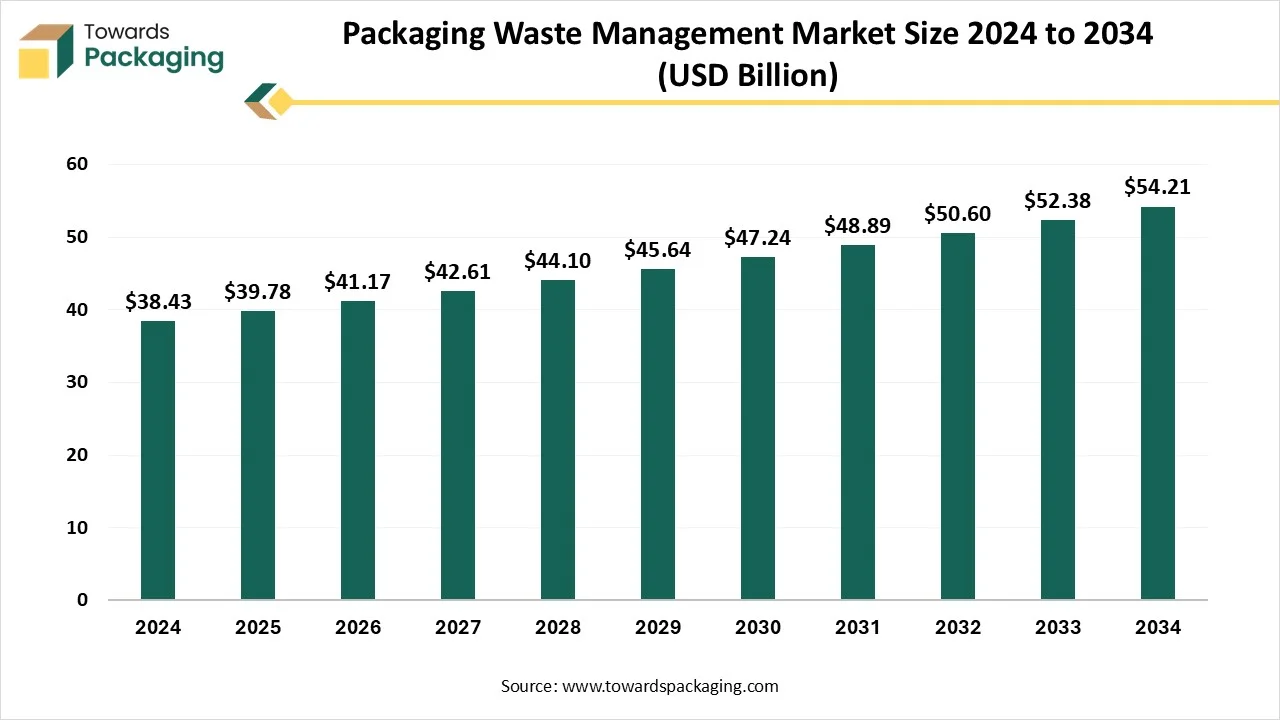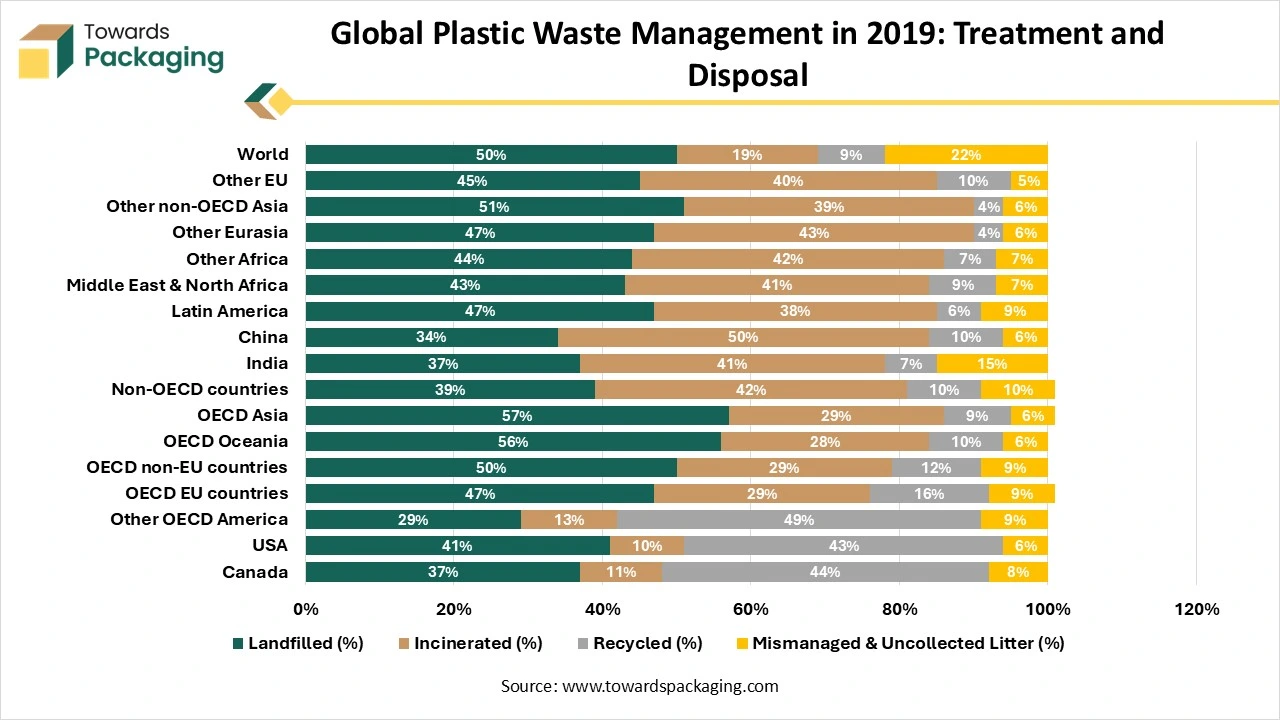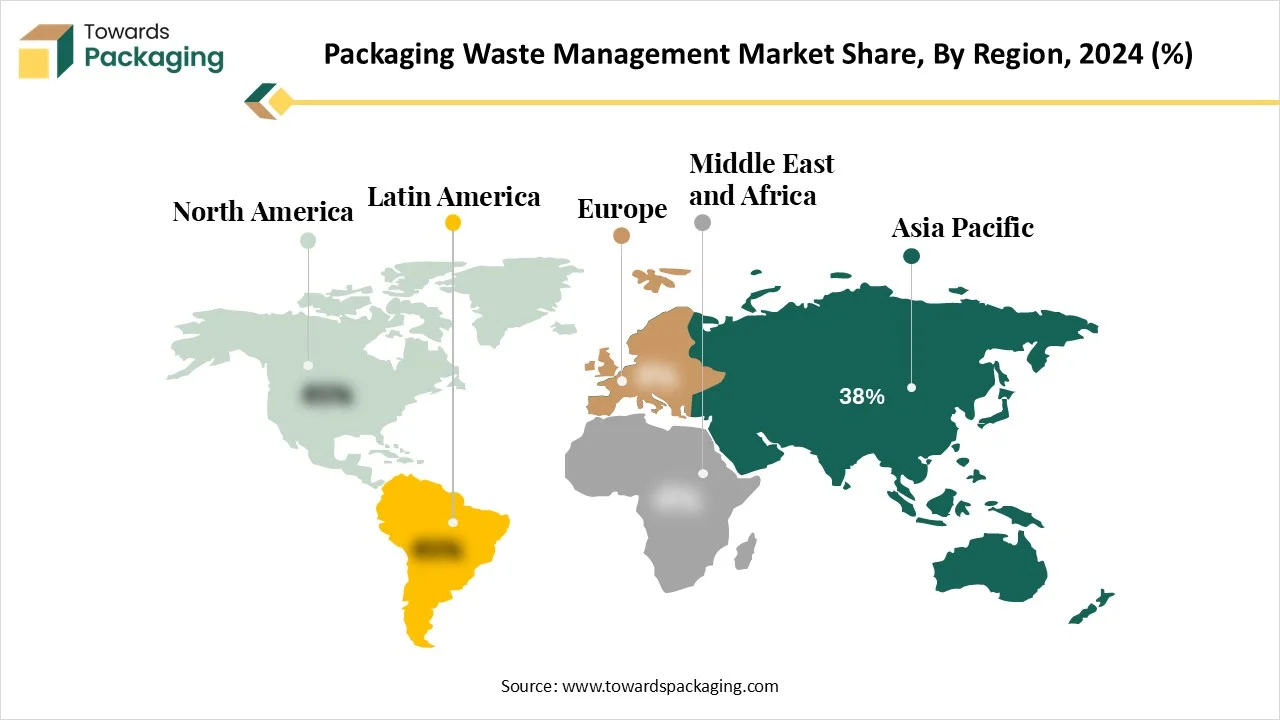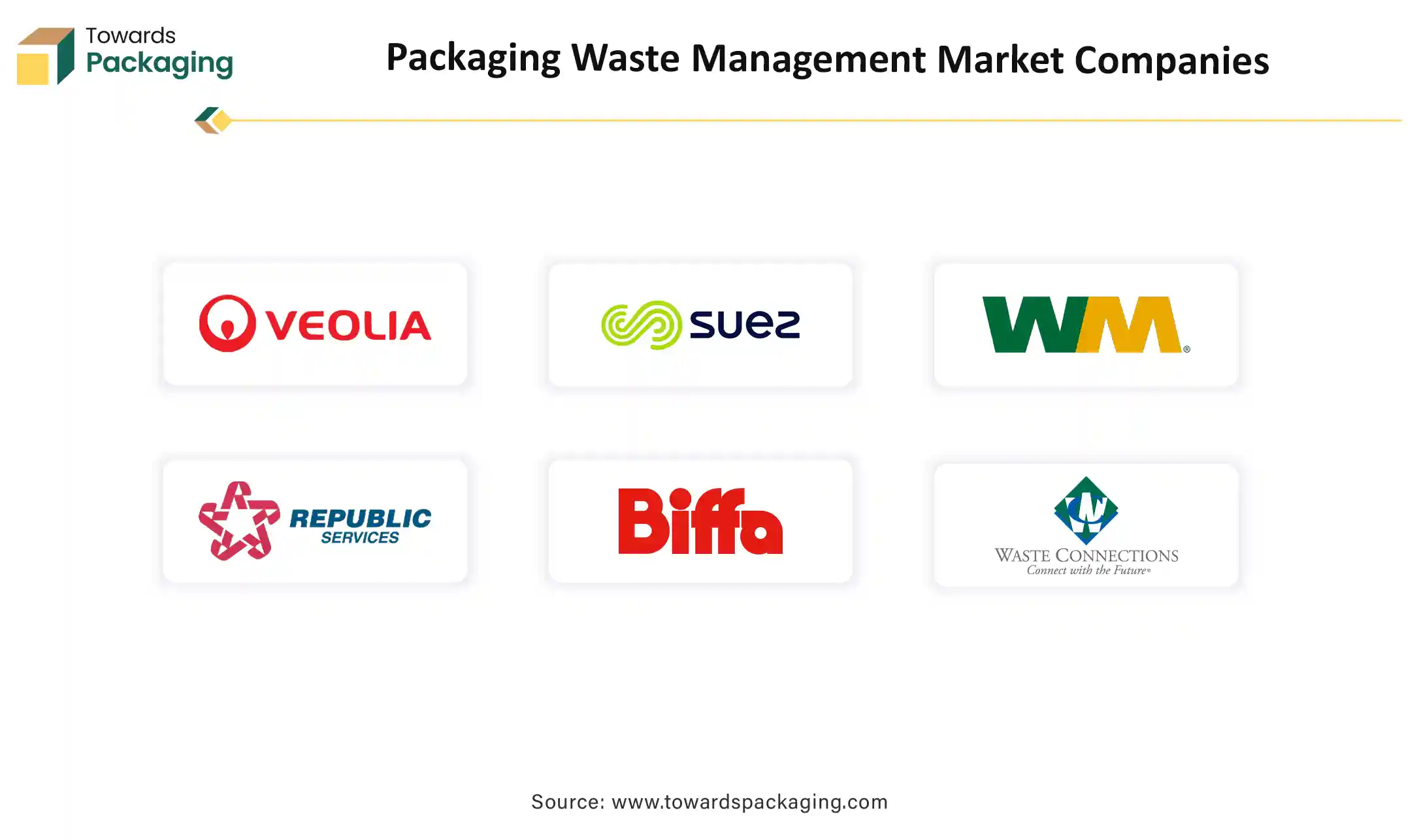December 2025
The global packaging waste management market is poised to grow from USD 39.78 billion in 2025 to USD 54.21 billion by 2034, with a projected CAGR of 3.5%. This market is driven by increasing environmental awareness, rising consumer demand for sustainability, and growing governmental regulations. Asia Pacific held a dominant 38% share in 2024, while plastic waste made up 40% of the waste type segment. Key players include Veolia Environnement S.A., Suez S.A., and Waste Management, Inc., who are advancing their technologies in recycling and resource recovery to meet the global demand.
Several key players operating in the packaging waste management market are focused on adopting growth strategies like acquisitions and mergers to develop advanced technology for packaging waste management, bolstering the market’s expansion in the coming years. In addition, the market is expanding exponentially in various developing and developed regions, particularly Asia Pacific, fuelled by the rising focus on sustainability and rising investment in recycling infrastructure.

The global packaging waste management market focuses on the collection, sorting, processing, and disposal or recovery of packaging materials after their intended use. This market is crucial for addressing the growing global issue of packaging waste, driven by the increased consumption of packaged goods and heightened awareness of environmental pollution. It encompasses various strategies, ranging from traditional landfilling and incineration to more sustainable approaches, such as recycling, composting, and waste-to-energy conversion, to minimize environmental impact and promote a circular economy for packaging materials.
As AI technology continues to evolve, artificial intelligence integration holds great potential to reshape the landscape of the packaging waste management market by automating the packaging waste management process to meet sustainability goals and reduce environmental impact. Waste collection, sorting, and recycling are significantly enhanced through AI-powered automation, which assists in lowering the dependency on manual labor and reducing the risk of errors. Several companies are widely adopting AI-driven waste management systems, which assist in tracking and reducing packaging waste, facilitating circular economy initiatives. AI utilizes computer vision and machine learning to automate waste identification, optimizing collection processes, and improving sorting accuracy.
| Metric | Details |
| Market Size in 2025 | USD 39.78 Billion |
| Projected Market Size in 2034 | USD 54.21 Billion |
| CAGR (2025 - 2034) | 3.5% |
| Leading Region | Asia Pacific |
| Market Segmentation | By Waste Type, By Service Type, By Source, By End-Use and By Region |
| Top Key Players | Veolia Environnement S.A., Suez S.A., Waste Management, Inc., Republic Services, Inc., Biffa plc, Waste Connections, Inc., Remondis AG & Co. KG, Stericycle, Inc., Covanta Holding Corporation. |
How is the Rising Environmental Awareness Supporting the Market’s Growth?
The increasing awareness regarding the environmental impact of packaging waste, especially plastic, is spurring the demand for effective waste management solutions, which further boosts the growth of the packaging waste management market during the forecast period. Over 460 million metric tons of plastic are produced every year, according to the United Nations Environment Programme. Plastic is widely used in a wide variety of applications across various industries, from construction and vehicles to electronics and agriculture. An estimated 20 million metric tons of plastic litter end up in the environment every year.
Plastic pollution adversely affects all land, freshwater, and marine ecosystems, a major reason for biodiversity loss and ecosystem degradation. Businesses and consumers are increasingly becoming more environmentally conscious, which creates the pressure to reduce packaging waste. Additionally, rising concerns regarding climate change and resource depletion have compelled industries, governments, and NGOs to adopt waste management solutions. Governments around the world are increasingly implementing regulations to promote packaging waste management practices such as extended producer responsibility (EPR) schemes, a ban on single-use plastic, and offering incentives to businesses to invest in recycling infrastructure.
High Initial Costs
The high upfront capital investment is required to establish waste management systems, including collection, sorting, and processing facilities, which can be a barrier for some companies and municipalities in middle and lower-income countries. In addition, a lack of consumer awareness regarding proper waste disposal often leads to improper sorting and a lower recycling rate. Such factors may hinder the growth of the global packaging waste management market during the forecast period.
Increasing Consumer Demand for Sustainability
The growing emphasis on sustainability is projected to create immense growth opportunities for the packaging waste management market in the coming years. Consumers are actively seeking eco-friendly alternatives and are willing to pay more for sustainable packaging options. The packaging waste management practices assist in significantly reducing pollution levels, marine debris, and landfill overflow, which often pose threats to both ecosystems and human health. The growing consumer preference for sustainable packaging materials is compelling businesses to invest in recycling technologies for eco-friendly packaging solutions. Several industries globally are increasingly adopting advanced sorting and processing technologies to make recycling facilities more efficient for developing recycled packaging materials, which significantly reduces the carbon footprint in the ecosystem.

In 2019, global plastic waste reached 353 million tonnes, more than double the 156 million tonnes produced in 2000. A significant portion of this waste came from short-lifetime applications like packaging, consumer products, and textiles. However, only 15% (55 million tonnes) of this waste was collected for recycling, while 22 million tonnes became recycling residue, requiring additional disposal. Of the total plastic waste, 9% was recycled, 19% was incinerated, and nearly 50% was sent to sanitary landfills. Unfortunately, the remaining 22% was mismanaged, either dumped in uncontrolled sites, burned in open pits, or leaked into the environment.
In 2023, the European Union made notable strides toward sustainability in packaging waste management. The EU generated 79.7 million tonnes of packaging waste, which amounts to 177.8 kilograms per person. While this was an improvement from 2022, with a decrease of 8.7 kg per person, it still remains 21.2 kg higher than in 2013, reflecting the growing demand for packaging materials over the years.
Paper and cardboard made up the largest share of packaging waste at 40.4%, followed by plastic at 19.8%, glass at 18.8%, and wood at 15.8%. Metal accounted for 4.9%, with the remaining 0.2% consisting of other materials. Each EU citizen produced, on average, 35.3 kg of plastic packaging waste, out of which 14.8 kg was recycled. Compared to 2022, this was a reduction of 1 kg in waste generated, but a slight increase of 0.1 kg in recycling. Over the past decade, plastic packaging waste per person has risen by 6.4 kg, but the recycling rate improved by 3.8 kg per person.
In terms of plastic recycling, the EU successfully recycled 42.1% of plastic packaging in 2023, an improvement from the 38.2% rate in 2013. However, recycling performance varies widely across EU member states. Belgium is a leader in recycling with a rate of 59.5%, closely followed by Latvia (59.2%) and Slovakia (54.1%). On the other hand, some countries like Hungary (23.0%), France (25.7%), and Austria (26.9%) have much lower recycling rates.
The EU has also made significant progress in reducing plastic bag usage. In 2023, the average person used 65 plastic bags, which is 30 fewer bags per person than in 2018. Countries like Sweden, Lithuania, and Latvia led the way with reductions of 131, 125, and 118 bags per person, respectively.
Several EU countries are already achieving the recycling target of 70% for packaging waste set for 2030. Belgium, Netherlands, Italy, Czechia, Slovenia, Slovakia, and Spain have already met or exceeded this target, while six other countries are close, with recycling rates above 65%.
While the EU has made significant progress, challenges remain, especially in countries with lower recycling rates. However, the overall reduction in plastic bag consumption and the growing number of countries surpassing recycling goals show that the EU is on track to achieve its long-term sustainability objectives.
In 2023, the European Union generated 79.7 million tonnes of packaging waste, which equals 177.8 kg per person. While this is an improvement from 2022, where the average was slightly higher, it’s still a significant increase compared to a decade ago. The waste produced mainly consists of paper and cardboard (40.4%), followed by plastic (19.8%), glass (18.8%), and wood (15.8%). Although most countries followed this trend, Bulgaria was an exception, where plastic waste exceeded paper and cardboard.
Plastic packaging waste continues to be a major concern. In 2023, each person in the EU produced an average of 35.3 kg of plastic packaging waste. This figure has risen by 6.4 kg per person since 2013. However, recycling efforts have improved. In 2023, 42.1% of plastic packaging waste was recycled, a significant increase from 38.2% in 2013. Belgium led the EU with a recycling rate of 59.5%, followed by Latvia (59.2%) and Slovakia (54.1%). On the other hand, Hungary had the lowest recycling rate, at just 23.0%.
In addition to recycling, the EU made progress in reducing plastic bag usage. The average person in the EU used 30 fewer plastic bags in 2023 compared to 2018, with Sweden, Lithuania, and Latvia seeing the biggest reductions.
Over the past decade, packaging waste generation and recycling in the EU have fluctuated. In 2023, the amount of packaging waste per person decreased by 4.7%, reaching 177.8 kg, compared to 2022. The highest level of waste generation was in 2021, with 190.1 kg per person. Recycling followed a similar pattern. In 2023, 120.0 kg of packaging waste per person was recycled, a small drop from 121.8 kg in 2022. However, recycling rates generally rose from 2014 to 2021, despite a few minor declines in 2018 and 2020.
Packaging waste generation varies greatly between EU countries. Ireland had the highest waste generation, with 223.1 kg per person, while Bulgaria had the lowest, at just 80.9 kg per person (data from 2022). Fifteen EU countries generated more than 150 kg of packaging waste per person. Countries like Italy, Germany, and Luxembourg exceeded 200 kg, while Bulgaria, Cyprus, and Croatia produced less than 100 kg of packaging waste per person.
Despite generating high amounts of packaging waste, countries like Italy, Germany, and Luxembourg also showed strong recycling efforts. Italy had the highest recycling rate at 162.2 kg per person, followed by Germany (149.3 kg), Luxembourg (132.4 kg), and Ireland (131.6 kg). On the other hand, Croatia, Bulgaria, and Romania recorded the lowest recycling rates.
The EU has set ambitious recycling targets for 2030. It aims to recycle at least 70% of all packaging waste by weight. Specific targets include recycling 85% of paper and cardboard, 75% of glass, 55% of plastics, 80% of ferrous metals, 60% of aluminum, and 30% of wood. These targets reflect the EU’s commitment to creating a more sustainable and circular packaging system.
The plastic waste segment held a dominant presence in the circular economy in the packaging market in 2024. The growth of the segment is mainly driven by the rising environmental awareness of plastic pollution, rising regulatory pressures, and increasing consumer demand for eco-friendly packaging. Plastic consumption has significantly increased in the packaging sector. Single-use plastics, such as packaging, bottles, caps, cutlery, and others, are the major contributors to plastic waste. These items are generally discarded after one use, which creates a significant environmental burden. According to the Organisation for Economic Co-operation and Development, in February 2022, only 9% of plastic waste is recycled, while 22% is mismanaged globally.
According to recent secondary data, approximately 11 million tonnes of plastic enter the oceans annually, which poses a threat to marine life, as many species ingest plastic particles as they consider their food. As plastic waste is a major component of packaging waste, it increases the need for effective plastic packaging waste management for environmental sustainability. Moreover, rising government initiatives and regulations aimed at reducing plastic waste and promoting recycling infrastructure are expected to drive the segment’s growth during the forecast period.
The landfilling segment held a dominant position in the packaging waste management market in 2024. A large portion of packaging waste ends up in landfills, which creates the need for a landfilling method. Landfilling remains a dominant segment, owing to the various factors such as the presence of inadequate waste management infrastructure in undeveloped countries and reduced initial costs. Landfilling is a widely adopted method for packaging waste disposal, particularly for plastics. The importance of landfilling has substantially increased with the surge in plastic waste generation and increasing awareness of environmental degradation.
On the other hand, the recycling & resource recovery segment is expected to grow at a significant rate, owing to the rising environmental awareness, growing emphasis on sustainability, rising regulatory pressures, and increasing demand for recycling packaging materials. Recycling and resource recovery involve the collection, sorting, and reprocessing of packaging materials such as plastics, paper, glass, and metals. Recycling can be cost-effective and more sustainable when compared to landfilling or incineration, especially in the long run. Several prominent market players are increasingly investing in mechanical recycling and reusing packaging materials with an aim to reduce their carbon footprint and boost sustainability. Stringent government regulations and policies like Extended Producer Responsibility (EPR) schemes aim to promote waste reduction and recycling practices, bolstering the segment’s growth during the forecast period.
The residential segment accounted for a significant share of the packaging waste management market in 2024. The growth of the segment is mainly driven by the rising population and rapid urbanization. The market has witnessed the increased consumption of packaged goods in the residential sector, resulting in a high volume of household waste generation. The adoption of effective packaging waste management is a crucial step toward reducing the environmental impact on the ecosystem.
The industrial sector accounts for a significant portion of packaging waste originating from industrial activities, which has led to an increasing need for effectively managing packaging waste. These packaging waste management services focus on managing and processing the large volumes of industrial packaging waste with an aim to reduce landfill waste and promote a circular economy for packaging. Moreover, chemical recycling is gaining immense popularity to tackle the rising problem of waste plastic pollution by offering an innovative way to reuse and recycle plastic waste. It assists in reducing greenhouse gas emissions and relieves pressure on landfill capacity.
The new packaging production dominated the packaging waste management market in 2024, owing to the rising consumer demand for recycled and eco-friendly packaging materials and surging investment in improving recycling technologies. Companies are increasingly focusing on developing recycled packaging solutions without compromising performance and functionality. In addition, the incorporation of recycled packaging materials marks a shift towards a circular economy, with a strong focus on optimizing the use of available resources. On the other hand, the construction segment is expected to grow at a notable rate during the forecast period, owing to the rising emphasis to promote of sustainability and lowering the dependency on virgin materials. Recycled materials are extensively utilized for various applications in the construction industry. The most common recycled materials include recycled steel, reclaimed wood, crushed concrete, recycled glass, recycled plastic, and others. The increasing use of recycled materials in the construction industry assists in conserving natural resources and significantly reduces greenhouse gas emissions associated with material extraction and production.

Asia Pacific held the dominant share of the packaging waste management market in 2024. Consumers and businesses in the region are increasingly prioritizing sustainability, which has led to an increasing demand for recycled and reusable packaging solutions as well as the adoption of efficient waste management systems. The growth of the region is mainly attributed to the strong presence of packaging recycling infrastructure, rising concerns about the environmental impact of packaging waste, a supportive government framework, increasing innovation in sorting and processing technologies, rising demand for recycled packaging solutions, high consumer spending on sustainable packaging solutions, and growing focus on aligning with the principle of the circular economy.
The rapid urbanization in the region, particularly in developing countries, is anticipated to fuel the market expansion in the coming years. The urban areas generate more packaging waste, requiring robust packaging waste management infrastructure and services. Businesses operating in the region are facing regulatory pressure from investors, consumers, and the government to adopt eco-friendly practices for reducing packaging waste and boosting environmental sustainability. Furthermore, the surging investment in recycling and green technologies, such as chemical recycling, is substantially enhancing the possibilities for managing different types of packaging waste

By Waste Type
By Service Type
By Source
By End-Use
By Region
December 2025
December 2025
December 2025
December 2025